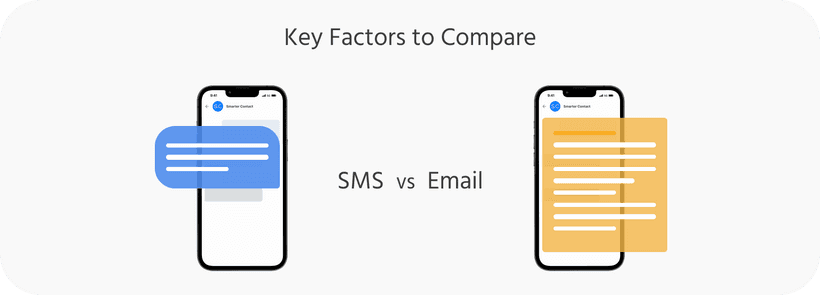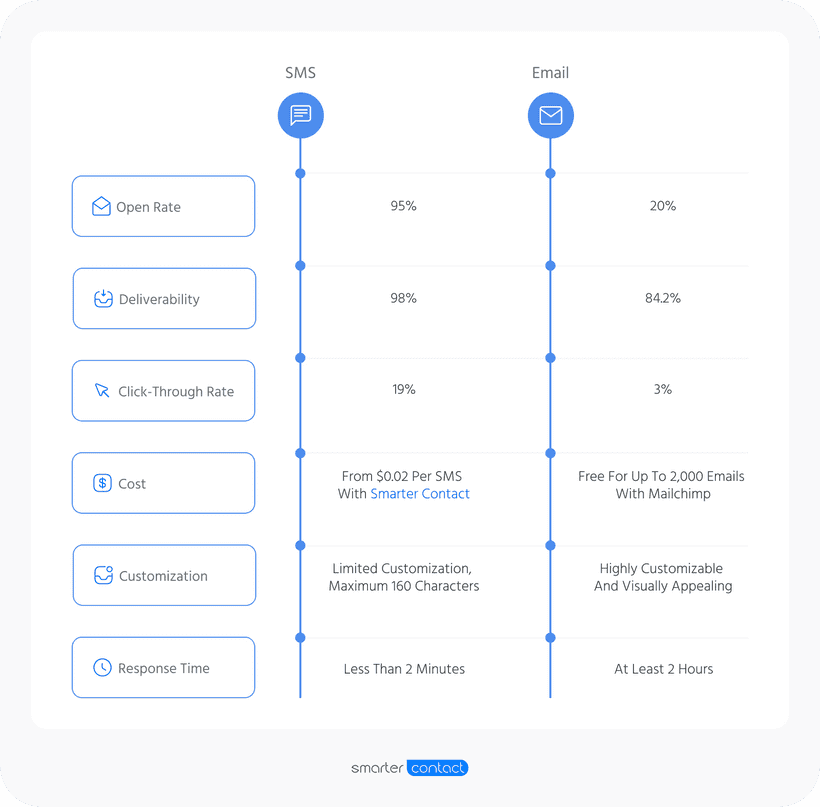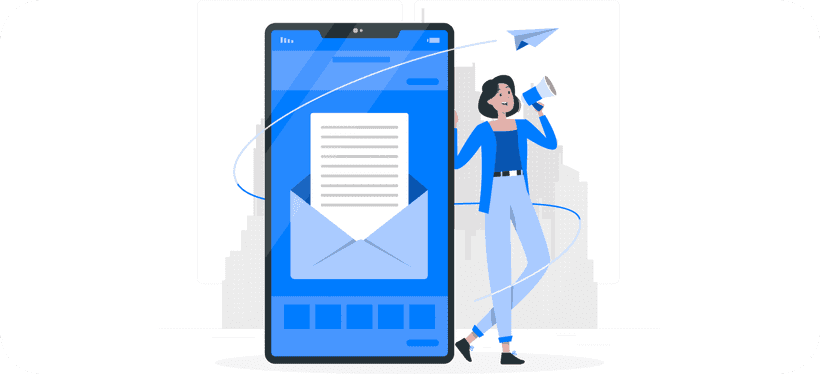SMS vs Email Marketing: The Only Comparison Guide You’ll Need
The SMS vs email marketing debate is a hot topic nowadays with increasingly more users turning away from their desktop and instead to their mobile phones for just about anything. Now, most of the time, consumers use the same device to read both their emails and text messages. In fact, according to mobile statistics, more than 80% of people use their smartphones to access their inboxes. What’s more, Americans check their phones over 340 times per day on average.
This has a huge implication for marketing teams and how they plan their marketing strategies and build relationships with their target audience. No wonder SMS marketing has become a very popular marketing channel for brands.
How does it compare to email marketing, though? Is there a clear winner or is it better to use both? Let’s explore!
What Is SMS Marketing?
SMS marketing (or text message marketing) is a type of marketing that brands use for sharing promotions, surveys, reminders, etc. by means of text messages. Marketers, though, may only send SMS messages to users who’ve opted in to receive communication from them.
What Is Email Marketing?
Email needs no introduction. As one of the older forms of communication, it’s often used for marketing. In short, email marketing refers to when businesses use email to market services or products. Just like with SMS marketing campaigns, users need to opt in to join the brand’s subscriber list.
SMS vs Email Marketing: Key Factors to Compare

One of the biggest challenges that marketers face is identifying which channel and strategy will deliver the best return on investment (ROI). If you’re stuck in that boat and need to decide whether or not you should use SMS or email (or possibly even both), here are a few key factors to keep in mind.
Open Rate
When it comes to open rate specifically, SMS is the clear winner. The average open rate for SMS is more than 95%. On the other hand, the average open rate for email is only about 20%.
Deliverability
Deliverability plays a key role. After all, your marketing campaign won’t work if your target audience doesn’t receive your marketing messages, right?
According to a study completed by EmailToolTester, the average deliverability rate across various email marketing platforms is about 84.2%. In other words, about 15% of all emails that were sent didn’t reach the primary inbox of the recipient. These messages most likely landed up in the Spam folder or disappeared into the abyss. That said, it’s important to remember that these rates can vary over time.
While the average deliverability rate of email is rather high, SMS is once again the winner. With an average delivery rate of as high as 98%, it’s one of the most reliable communication mediums.
Click-through Rate
While text messages are much shorter than emails, it can actually play in their favor when it comes to click-through rate. In a nutshell, click-through rate (or simply CTR) refers to the ratio of the number of clicks that a promotional SMS or email gets during a campaign to the number of times the message was seen.
When it comes to SMS marketing, the CTR is about 19%. Once again, email performed worse with email statistics revealing an average CTR of about only 3%.
Cost
There are a number of factors that will impact the cost of your SMS marketing campaign. These include the length, region, service provider, carrier, and the number of text messages that you plan to send.
If you’ll be using SmarterContact, you’re looking at about $0.03 per SMS if you plan on sending fewer than 3,000 messages per month. The more you send, the cheaper the rate. For unlimited text messages, it’s only $0.02 per SMS.
It usually costs less to run an email marketing campaign. That said, the cost can also vary depending on the level of customization and campaign type. For example, if you’ll be using Mailchimp, you can send up to 2,000 emails per day (though, no more than 10,000 per month) for free. To reach 50,000 contacts, you’re looking at about $300 per month for a maximum of 500K emails per month.
Customization
While the shorter length of a text message plays to its advantage when it comes to click-through rate, this is not the case for customization. Emails offer many more customization options than text messages, making them better if you need to share more details. For example, you can add colorful banners that match your branding, a business logo, user-generated content, etc. With text messages, though, you’re limited to only text. Plus, you may not use more than 160 characters.
Response Time
The average response time for text messages is significantly higher than email. The average response time for text messages is less than two minutes. In fact, according to SMS statistics, consumers answer text messages up to 30 times faster than email. When it comes to emails, most people respond to emails within two hours, but it can take as long as two days (that’s if you get a reply).

Advantages of SMS Marketing
They say that dynamite often comes in small packages. Text messages might be limited to only 160 characters, but that doesn’t mean that it can’t be of service. Here are some of the main perks of texting and SMS marketing:
-
Better Engagement
As the statistics mentioned above show, recipients are more inclined to click on a link sent via SMS and they’re also usually faster to read and respond to the message. So, when you send a text message, the chances are very good that you can encourage two-way communication.
-
Automation Opportunities
Thanks to marketing tools like Smarter Contact, it’s easy for businesses to send promotional text messages to a group of people automatically. Using pre-built messaging campaigns, you can save hours each day by following up with leads automatically.
-
Trustworthy
While text messaging is a newer form of marketing, it has gained the trust of consumers. Not only has the majority of US consumers indicated that SMS marketing improves the customer experience, but they also view it as a more trustworthy channel and the links shared in text messages as legitimate.
-
Instant and Direct
Unlike marketing emails, with SMS marketing, there’s no need to worry about spam folders. If the recipient opted in to receive communication from you, your text messages will be delivered straight to their phone number. Then, once a message has been received and read, it’s also quick to respond. Often, all the user needs to do is text “Yes” or “No”. That’s it!
Cons of SMS Marketing
While its short length can be an asset, it’s also the cause of some of the cons associated with SMS marketing. The following are some of the disadvantages of SMS marketing that you should keep in mind when you’re planning your next marketing campaign.
-
Cost
Sadly, you have limited control over the cost. The region’s carriers will determine the cost per text. This also makes it more difficult to budget.
-
Length
Marketers have only 160 characters that they can use per text message. This makes it quite challenging to communicate a lot of details. While you can use abbreviations, there’s still some business texting etiquette that you need to consider. After all, you don’t want to come across as unprofessional or let the meaning become vague.
Advantages of Email Marketing
While email marketing might not deliver the best rates, it does offer a number of advantages. Here are some of the main benefits it can offer:
-
Impressive ROI
Email marketing boasts a very high ROI. According to statistics, for every $1 that you spend on email marketing, you can generate about $40.
-
Trustworthy
Sure, you get the occasional email scam. However, the majority of consumers identify email as their preferred method of communication with businesses. A branded email creates a sense of trust and can help brands to communicate that they’re an authentic and reliable brand. So, when done right, it can help brands to create a deeper connection with their target market.
-
Customization and Automation Possibilities
As email messages are longer than SMS, it offers brands much more customization opportunities like adding a company logo, a signature, or a list of recommendations based on their previous purchases. Plus, there are many tools available that can help you to automate your email marketing campaigns without making the emails sound less personal.
-
Cost-effective
According to data shared by WebFX, a mid-sized business can expect to spend anything from only $9 to $1,000 per month on email marketing. This makes it one of the most affordable marketing strategies.
Cons of Email Marketing
While you can say much more with an email, its length can become a hurdle. Here are some of the main disadvantages of using it for marketing purposes:
-
Low Open Rate
Each day, consumers get loads of emails. This makes it more challenging for brands to let their emails stand out among the sea of other messages. As a result, the open rate and click-through rates are lower than other communication mediums like text messaging.
-
Spam Filters
The majority of email service providers have strict spam filters. Though, just because your email made it past the filters doesn’t mean that your readers won’t view it as spam. If you don’t incorporate some form of personalization by, for example, including the recipient’s first name, it’s easy for your email to be interpreted as just another email trying to make a sale.
4 Steps for Successfully Leveraging both SMS and Email

To help you make the best of both channels, here are four simple steps that you can follow.
-
Understand the Difference and Proper Use Case
As mentioned, there are a few key differences between email and SMS. So, it’s important that you keep these differences in mind when you create your marketing strategy. For complex information, it’s best to stick to email. On the other hand, it’s better to send messages when you need to send notifications to remind them about an appointment or inform them about a flash sale.
-
Create Synergy Between Both Channels
The truth is neither email nor SMS will work all the time. In some instances, it’s better to opt for email, while other times call for text messages. So, it’s best to merge both channels by creating a synergy between the two. Also, it’s better to have a 360-degree communication plan and cater your communication to a user’s profile.
-
Make the Most of SMS and Email
After you’ve received permission to contact your subscriber list via email or SMS, here are some of the ways that you can make the most of SMS and email marketing.
For SMS:
- Use it sparingly by limiting your text messages to once a week
- Use it to ask customers for their feedback or to offer a deal or special access
- Use SMS over email for time-sensitive matters like a promo that ends at midnight
For email:
- Use it sparingly at first (one email every second week) and then increase it to once a week
- Use it for long-form content
- Use it to share interactive experiences like an embedded form
-
Analyze the Result and Do Your Homework
Whether you use email or SMS, it’s key that you take the time to analyze the results of your campaign. This “extra” step will show you where you can improve. Perhaps you sent it at the wrong time of the day? Or, maybe there’s a certain day that has a better CTR? Learn from these discoveries and see how you can connect with your audience across various touch points more successfully.
Final Verdict: Email marketing OR SMS marketing
There is no clear winner between email marketing or SMS marketing. In some areas, like cost and customization, email marketing performs better, while in other areas your text marketing campaign will deliver better results. So, the final decision is up to you and your needs.
However, instead of viewing it as SMS vs email marketing (in other words, as either or), why not use both? When used in synergy, you can get the best of both worlds. For example, in those instances, when you have a time-sensitive deal you can opt for an SMS message, while for weekly newsletters that need to communicate more than just a code, you can use email. By using a combined approach, you can have more engaged customers and eventually closed deals while keeping the cost down.
Inna Shevchenko
inna@smartercontact.com

